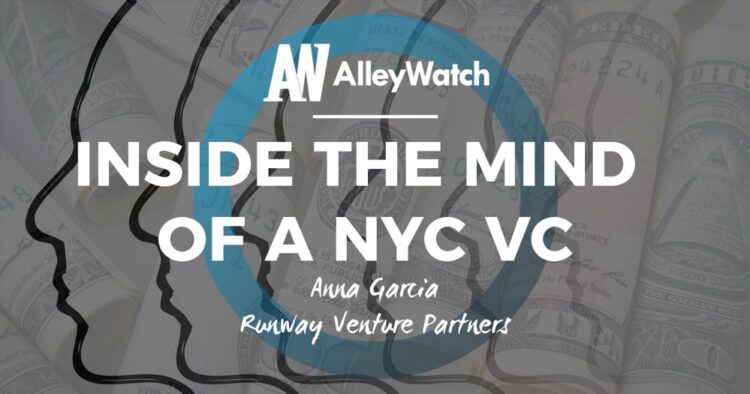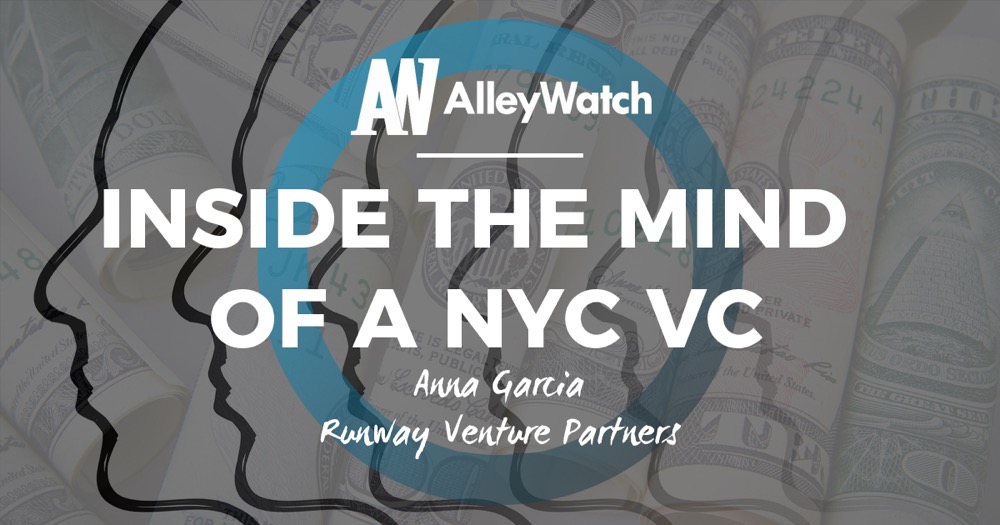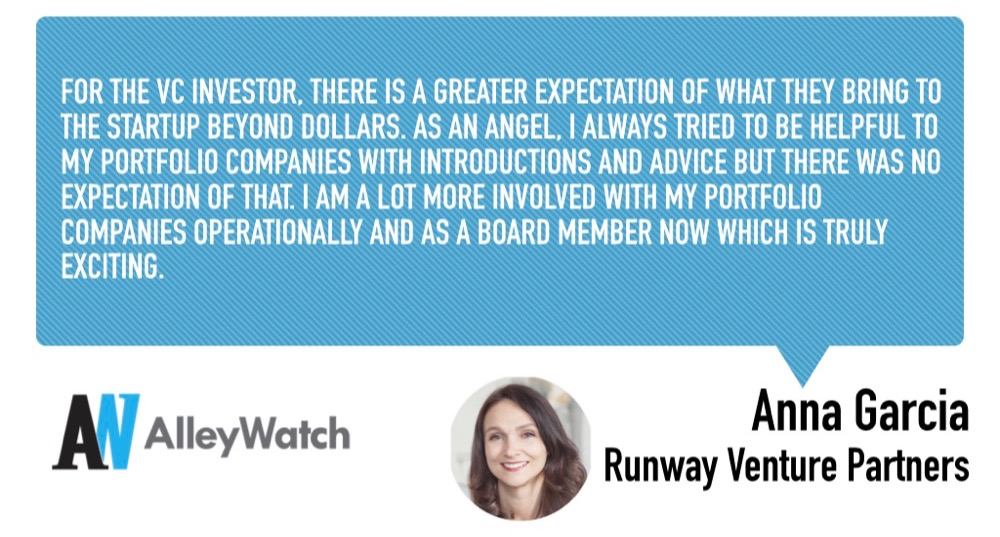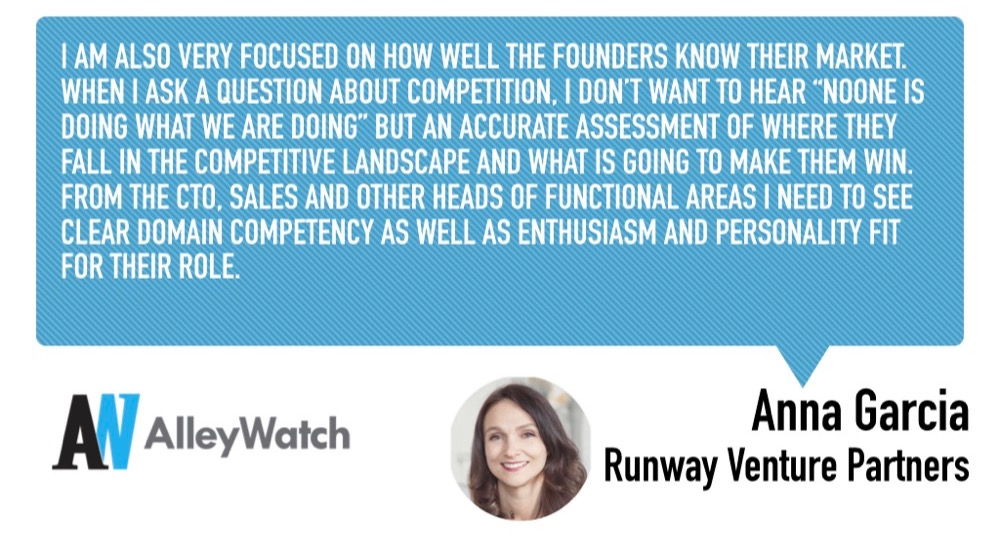Welcome back to Inside the Mind of an NYC VC, a highly acclaimed series at AlleyWatch in which we speak with New York City-based Venture Capitalists. In the hot seat this time is Anna Garcia, Partner at Runway Venture Partners, an early-stage fund focused on making investments in startups that are post seed with established product-market fit, often serving as seed extension capital prior to an A round. Founded in 2016 by Garcia and Marc Michel, Runway’s portfolio includes Trendalytics, Viyet (acquired by Sotheby’s), Superphone, and MarketMuse.
Anna joined us to discuss her path to startup investing after working in the capital markets for 17 years, the differences between angel investing and venture, diversity in tech, actionable tips for entrepreneurs on how to successfully raise funding and catch the attention of investors, and much, much more.
If you are a NYC-based VC interested in participating in this series, please send us an email. We’d love to chat. If you are interested in sponsoring this series that showcases the leading minds in venture in NYC, we’d also love to chat. Send us a note.
Reza Chowdhury, AlleyWatch: Please tell us a little bit about your background and how you started in venture.
Anna Garcia, Runway Venture Partners: I started out on Wall Street and had a pretty exciting career that spanned 17 years and roles in capital markets, investment banking and asset management. The bulk of my time in financial services was spent on a bond trading floor which, despite being housed within a large institution, was a highly entrepreneurial environment. The markets presented an opportunity to generate unique business every single day and that kept my entrepreneurial spirit alive. Post-2008 crisis, however, banking became weighed down by regulation and seized being a growth business. By contrast, there was undeniable momentum building in the tech startup community in New York. New York was cementing its place as the top venture capital destination outside of Silicon Valley and energy was everywhere.
It was very clear to me that technology was changing every aspect of how we live and that innovation was creating incredible economic value. And I wanted to be part of that process.
I always liked the markets and investing, so my first step in getting to know the startup world was to become an active angel investor. I felt that investing personal capital was key to building credibility in the early stage community. As I got started, I quickly realized that access to quality deal flow was critical. So, while still working in banking, I focused on relationship building and with time got myself into the position of filtering hundreds of deals and mentoring at accelerator programs such as ERA, Barclays/Techstars and the Canadian Technology Accelerator. Given my financial markets training, I was very disciplined and aggressive about portfolio construction. By the time I left Wall Street, I had a portfolio of a dozen direct investments and a couple of fund investments to augment my diversification. I also had several exciting advisory roles with fintech companies in front of me and I could not wait to jump in. I set up my own investment company called AGM Ventures and poured myself into full-time investing, advising and deepening my connections within the startup community.
 Complete independence was fun for a bit, but what I missed was the consistency of the intellectual exchange I had on Wall Street. I had built a great network of smart early-stage investors whom I respected, trusted and co-invested with, but we weren’t always in the same room to evaluate an investment together. I also found that as an angel I could only help a startup so much and felt that my impact could be much more meaningful if I had more capital to work with. I began thinking about launching a VC fund and looking for a partner to do that with.
Complete independence was fun for a bit, but what I missed was the consistency of the intellectual exchange I had on Wall Street. I had built a great network of smart early-stage investors whom I respected, trusted and co-invested with, but we weren’t always in the same room to evaluate an investment together. I also found that as an angel I could only help a startup so much and felt that my impact could be much more meaningful if I had more capital to work with. I began thinking about launching a VC fund and looking for a partner to do that with.
One of the people I got to know and built a terrific relationship over the years of angel investing was my now business partner, Marc Michel. Marc is a well-respected career VC and former entrepreneur with whom, I discovered, I had shared values and complementary skills that allowed us to challenge each other’s thinking and become better investors in the process. Luckily, Marc and I had the opportunity to co-invest and get to work together informally before either of us contemplated a new fund. Needless to say, I was very pleased that in 2016 Marc and I saw the same opportunity in the early stage venture market and formed Runway Venture Partners.
How does investing as a VC differ from investing on your own, as you did previously?
Being an angel was great training. One important realization was that as an angel you experience a lot of adverse selection and that you have to stay very disciplined and methodical about your process. As a VC, you also have to stay committed to your process, but the deal flow is substantially better.
The other key learning was that you are unlikely to be a successful early-stage investor part-time. Looking at it through an investment management lense, diversification is important in every asset class but it is paramount in venture. What’s different from the public markets, however, is that you cannot allocate to the private markets with one click of a button like you can by buying, say, a large-cap stock ETF. Even if you have the time and commitment to building a portfolio, it takes a very long time to accomplish that because the right deal does not come around every day. That is why most smart angels and family offices augment their portfolios by also investing in VC fund managers they know well. Investing as a VC is obviously a full-time endeavor and there is a lot to be said about doing this professionally vs as a hobby.
Lastly, for the VC investor, there is a greater expectation of what they bring to the startup beyond dollars. As an angel, I always tried to be helpful to my portfolio companies with introductions and advice but there was no expectation of that. I am a lot more involved with my portfolio companies operationally and as a Board member now which is truly exciting.
Does the firm have a specific thesis that it employs to guide investments?
Yes, it does. Runway invests in B2B software businesses across verticals but at a specific stage. We look for startups that have reached product-market fit but are not yet ready to execute the “new” Series A. Series A rounds have ballooned in size from $3-5M several years ago to an average of $10M today. This happened due to institutional capital pouring into alternative investments, including VC funds. As a result, Series A VCs’ check sizes per company increased and the number of players who want to lead a $3M “old’ Series A dropped.
This dynamic moved the goalpost for many well-executing startups preparing for a Series A, as they now had to show higher operating metrics to justify the larger investment. They generally need extra time to mature revenues without compromising growth rate and have to preemptively extend runway in order to approach a large A from a position of strength. In practice, we see startups seeking $2-3M of additional capital to comfortably accomplish this.
Securing a lead investor is particularly difficult for a startup at this stage. Part of our strategy is to act as a lead investor and bring additional value by catalyzing the funding round.
As investors, we think this stage offers a superior risk-return profile within the venture market. By focusing post product-market fit, we take the biggest risk off the table but invest at a significant discount to the going Series A valuations.
What can entrepreneurs expect when working with Runway Venture Partners?
First and foremost, honesty. We offer that and we expect that from our entrepreneurs so we don’t find ourselves blind sighted by problems at the last minute when it might be too late to do anything about them.
Other than that, we are involved investors and are available as much as our entrepreneurs need us on a day-to-day basis. This will vary from company to company depending on their pressing business challenges, but our help spans assistance on operational issues and recruiting to business development and capital introductions.
What are you excited about right now, from an investment standpoint?
While not necessarily a new theme, it is still an exciting and amazingly relevant one: SaaS. Businesses from small and mid-sized to enterprise still deal with massive process inefficiencies and are in need of process optimization. We continue to see a lot of workflow solutions and machine learning/AI-based tools that aim to make internal business processes faster, more transparent and intelligent.
I continue to be very interested in fintech defined as all companies selling to the financial services industry. Having come out of that industry, I feel that there is enormous potential on the institutional capital markets and asset management side. I hope to find and add to our portfolio some promising startups in that space.
What do you need to see from teams, both qualitatively and quantitatively, in order to invest?
In the CEO, I am looking for drive, vision and signs of true leadership. And yet, humbleness and willingness to take input. I am also very focused on how well the founders know their market. When I ask a question about competition, I don’t want to hear “noone is doing what we are doing” but an accurate assessment of where they fall in the competitive landscape and what is going to make them win. From the CTO, Sales and other heads of functional areas I need to see clear domain competency as well as enthusiasm and personality fit for their role.
Quantitatively, I look for a dozen or more paying clients and generally $50-100k MRR. The specific revenue metrics may shift with the market but this is representative of the companies we’ve been backing recently.
ICOs have increasingly emerged as another funding option for entrepreneurs. What are your thoughts on this growing trend?
There is a lot of noise in the world of ICOs at this time but there is no doubt in my mind that some form of the ICO model will stay…after a massive shakeout and introduction of a proper regulatory framework.
In the meantime, investors have to be aware of the dangers of ICOs. Some startups turn to ICOs because tokens are a crucial component of the functioning of their business, some startups go the ICO route because it is the latest buzzword and is available while the VC route is not. The latter group is the one I would urge investors to be particularly careful with.
The other thing to be mindful of is that ICOs offer an investment opportunity in the company’s promise to build something in the future. In most cases, nothing has yet been built or sold to customers. In other words, it is super early. Yet, huge amounts of money are being raised at this very early stage. This disconnect is not healthy. Even if you develop a cool technology, there is no guarantee you can turn it into a business.
All that said, I am watching the space and am very interested in its evolution.
What metrics do entrepreneurs overlook or not place enough emphasis on that are important to consider when you are evaluating investment merit of a business? What metrics are very specific to fintech businesses that are important?
Metrics vary by business and most entrepreneurs who know their market do a good job tracking them and refining them as the company matures. I mentioned that we invest primarily in B2B software, so the metrics I tend to dig into, like most VCs, relate to growth rate, gross margin, customer acquisition costs and lifetime value of a customer as well as other factors that ensure expense expansion goes hand in hand with the pace of revenue development.
Fintech is an interesting example of an industry where a lot of capital tends to get raised way before the revenue base justifies it. Fintech suffers from incredibly long sales cycles, especially if the startup is going after the large banks. Significant amounts of capital are often needed to support that as well as to support proper regulatory set up in certain instances. However, what I see often is fintechs that scale their expense base prematurely just because capital is available from Wall Street insiders or strategic investors who don’t have their finger on the pulse of early-stage VC valuations. These companies get stuck with massive burn rates relative to where they are as a business and that closes off the venture capital path for them until revenue catches up. I would encourage fintech founders to scrutinize their burn rate and make sure it is truly appropriate for their stage.
What can entrepreneurs do to ensure that the funding process is smooth from first meeting to getting to a round close?
Thoughtful follow-up and responsiveness are critical. Entrepreneurs should be proactive with business updates and not make investors ask for the same information multiple times. For me, the process from the first meeting until closing is part of the founder interview. If I see the founder drop the ball on communication with me or show a low level of thoughtfulness, I immediately imagine how that can happen in a client situation and/or with other investors.
What can entrepreneurs do to ensure that the relationship between the firm and companies is fruitful post investment?
A couple of important things. First, be proactive in communicating the good and the bad. We are not afraid of challenging news but we are afraid of getting them too late. Second, draw on our expertise and network. We are in it together and we are ready to help whichever way we can.
What are some things that you repeatedly see early-stage companies and founders struggle with?
Not doing enough research on the investors they are approaching. There is a belief out there that it is just a numbers game…but that is incorrect. Whether companies are reaching out directly or asking someone for an introduction, providing thoughtful reasons for why their business would be a great fit goes a long way in getting attention and minimizing time wasted.
Not doing enough research on the investors they are approaching. There is a belief out there that it is just a numbers game…but that is incorrect. Whether companies are reaching out directly or asking someone for an introduction, providing thoughtful reasons for why their business would be a great fit goes a long way in getting attention and minimizing time wasted.
From the operational point of view, the biggest challenge I see is recruiting. The amount of time and effort spent on finding the right talent is significant and the cost of a bad hire is very high.
You are quite involved with the Parity Professional Program (P3). Would you please tell us more about that?
I served as a Pod Leader, i.e. mentor, for the first year of P3 program. The program focuses on career advancement of women in financial services and other high impact industries. Parity Partners was started by several women I respect tremendously and I wanted to support the program in its inaugural year by volunteering my time and helping build community. While I stepped down for the second year due to time constraints, I remain a part of the support network.
Have you seen any shift in investment trends over the last year related to diversity and inclusion at a macro level?
I have not seen a material change. Or at least not yet. There is definitely a lot of conversation about improving capital access for female/minority entrepreneurs and new mission-driven pockets of capital for Seed/pre-Seed startups are being established. We have seen everything from small angel groups and micro funds to Goldman Sachs’ $50oM dedicated capital pool for female founders. Hopefully, these efforts will deliver impact over time.
Interestingly, these pools of capital are being established primarily as an alternative to traditional VC. I personally think we need to do a lot more inside the venture industry by encouraging diversity in investment teams. That will, in turn, bring a better balance in venture capital distribution.
I don’t currently see LPs requiring that more capital end up in the hands of female GPs or seeking out diverse managers in general. Greater capital allocations to female VC investors would enable them to support diverse founding teams with meaningful follow-on capital so that those businesses can continue to successfully scale beyond super early stages. As a female VC investor, I would like to see LPs prioritize diverse investing teams in their fund selection and commitments.
Quick Hits:
Who do you admire in the startup world and why?
Frankly and rather simply, I most admire the founders I have invested in and work with every day. Seeing their enthusiasm, grit and drive in action is what truly inspires me. I feel very fortunate to be sharing in their entrepreneurial journey and helping them in every small and big way I can.
What’s the last book you read?
Untangled by Lisa Damour. In my opinion, a must-read for parents raising daughters.
Are you binge watching anything right now?
Humans. An unsettling view of the future!
What’s your favorite outdoor summer activity in NYC?
I am more of an indoor, hot yoga-type person even in the summer. But if I had to pick, I would say walking around New York streets and soaking up the energy of the city.







